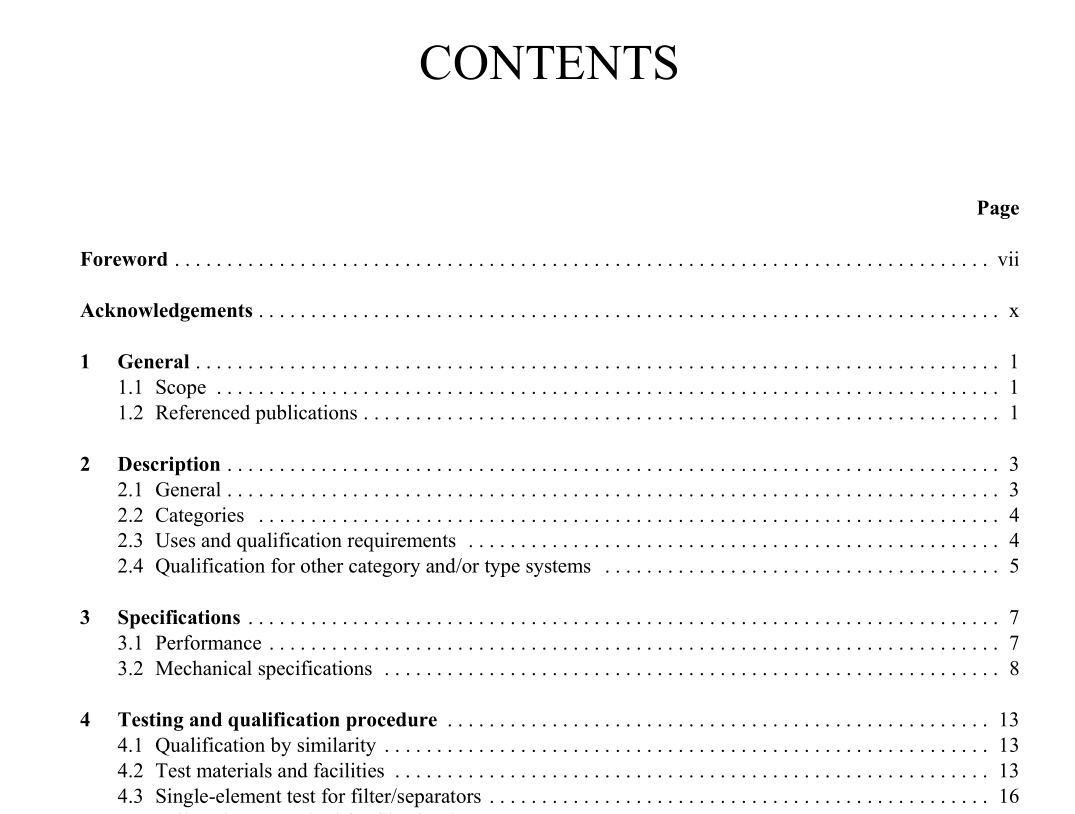API Spec 1581 pdf download

API Spec 1581 pdf download.SPECIFICATIONS AND QUALIFICATION PROCEDURES FOR AVIATION JET FUEL FILTER/SEPARATORS
2.1.1 Filter/separator A filter/separator is a vessel containing filter/coalescer and separator elements that continuously removes dirt and water from aviation jet fuel to levels acceptable for servicing modern aircraft. A filter/separator can have either a vertical or a horizontal configuration. A filter/separator can consist of multiple stages. 2.1.1.1 A two-stage system consists of filter/coalescer and separator elements contained within a vessel. The fuel flows through the filter/coalescer element(s) into the vessel and then flows through the separator element(s) to exit the vessel. 2.1.1.2 A multi-stage system consists of a two-stage system that contains one or more additional stages. Additional stages may include currently qualified devices 6 located within each separator element capable of shutting off fuel flow if the filter/coalescer and separator elements fail to remove water to an acceptable level. Additional stages may also include currently qualified devices 6 located within each coalescer element designed to remove dirt (prefilter) or contaminants (adsorption stage). 2.1.2 Filter/coalescer A filter/coalescer is an element that is capable of removing dirt and of coalescing fine droplets of water in the fuel to sizes that can be removed in the filter/separator vessel. Filter/coalescers are classified as Type S and Type S-LD (low dirt) according to the amount of dirt the elements are capable of removing as defined in Section 2.3. 2.1.3 Separator A separator is an element that prevents water droplets (coalesced by the filter/coalescer) from leaving the vessel in the effluent stream. 2.1.4 Filter/separators For the purpose of this specification, filter/separators are qualified for one or more of the three categories defined in Section 2.2.
2.3.3 Type S-LD filter/separators Type S-LD filter/separators (also known as coalescer/ separators) can be used at all filtration points in an aviation fuelling system where significant levels of water but minimal amounts of dirt can be expected in the jet fuel. Examples of suitable locations could be immediately after a microfilter (used to remove dirt to acceptable levels) or at locations where acceptable dirt levels can be achieved without filtration. The qualification requirements for coalescer/separators are: (a) The Type S-LD filter/separator shall be able to maintain rated flow when it is contaminated with particulate to the level specified in Section 4 without the contamination in the effluent fuel exceeding the level specified in Section 3.1.1. (b) The Type S-LD filter/separator shall be able to effectively remove water from fuel without exceeding the effluent free-water levels specified in Section 3.1.1 when water is added according to the procedures specified in Section 4. 2.3.4 Multi-stage systems 2.3.4.1 Multi-stage systems can be used at all filtration points in an aviation fuelling system where two-stage filter/separators are used but where additional performance or assurance is desired. Multi-stage devices include pre-filters (upstream of filter/coalescers) and water absorbing elements (downstream of separators). Water absorbing elements can be used for additional assurance that effluent water will not exceed the level specified in Section 3.1.1. Examples of such locations could be systems where surfactants or additives might impair filter/separator performance or on fuellers and hydrant servicers where an additional precaution may be desired to keep water from aircraft. 2.3.4.2 The qualification requirement for a multi-stage system is that the filter/separator shall be able to qualify under Section 2.3.2 or 2.3.3 when the multi-stage devices are installed. Note: This specification applies only to the filter/separator portion of the system.
3.1 PERFORMANCE
3.1.1 Contamination of effluent fuel Contaminants in effluent fuel samples, taken during the specified test procedure and analysed by the specified methods, shall not exceed the following limits: (a) Total solids content of 0,26 milligrams per litre (1,0 milligrams per gallon) by ASTM D-2276. (b) Free water content of 15 ppmv by ASTM D-3240. (c) Media migration of 10 fibres per litre (38 fibres per gallon). 3.1.2 Media migration Any particle in the effluent with a length-to-diameter ratio of 10:1 or more and a length of 100 microns or more shall be counted as a fibre. 3.1.3 Solids holding capacity 3.1.3.1 Type S filter/separators, as tested in the single- element test, shall hold a quantity of solids greater than or equal to 1,43 grams per litre per minute (19 mg/l x 75 minutes) (5,4 grams per gpm) of rated flow. The unit shall hold 67 % of the specified quantity of solids without exceeding a differential pressure of 105 kPa (15 psi) and shall hold the total specified quantity of solids without exceeding a differential pressure of 315 kPa (45 psi).









